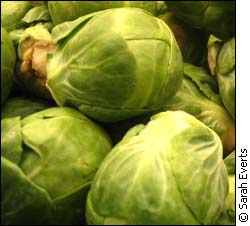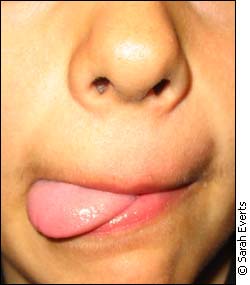| Taster's
choice: the science
of loving lunch
By Sarah Everts
OTTAWA —
If Brussels sprouts on your plate make you miserable,
your DNA just might be at fault.
 |
| Some food aversions are genetic. |
Benedicte Fontaine-Bisson was 24 years
old when she discovered her genes were to blame for
her dislike of bitter food. She’s a ‘supertaster,’
so sensitive to bitter flavours that it’s almost
unbearable for her to taste broccoli, coffee, wine and
beer. But some people’s genetic makeup excludes
them from tasting what she is so responsive to.
Genetics is only one ingredient in the
recipe for human flavour experience. The adage ‘you
are what you eat’ is being recast as researchers
uncover that what you eat mirrors who you are—genetically,
historically and socially.
“Food preference is a wonderful
example of a behaviour that involves every aspect of
our being,” says John Prescott, a taste scientist
at John Cook University in Cairns, Australia. For many
years the genetics of food preference “wasn’t
really anywhere and now it’s growing pretty rapidly.”
 |
| Supertasters are sensitive
to a compound in Brussel sprouts called PTC. |
Fontaine-Bisson found out she was a supertaster
when she participated in a simple experiment at the
University of Toronto. She was given a piece of paper
to taste that contained just micrograms of a bitter
compound called PTC, or phenylthiocarbamide. It's like
a chemical present in vegetables like broccoli, Brussels
sprouts and cabbage.
“Some other people tried it before
me and they said, ‘Oh I can’t taste it,
I can barely taste it,’ so I tried it, and oh
my god, I had to spit it in the garbage. I became flushed,
all red, I almost wanted to vomit it was so strong for
me. And I couldn’t understand why other people
could barely taste it.”
The genetics of supertasting
Research shows that between a quarter
and a half of all people have a taste receptor on their
tongue whose genetic sequence cannot detect the bitter
PTC. The rest of us can. Then there’s the supertasters.
Not only can Fontaine-Bisson taste PTC, she’s
got extra bitter receptors in her taste buds that pack
an extra punch.
“If you look at the tongues of non-tasters,
tasters and super tasters you can see a progression
from sparsely populated [taste buds], to more densely
populated to extremely densely populated,” says
Prescott.
| 'Now people
don’t push me to drink or eat bitter foods.
I have a kind of explanation, something more scientific.' |
More taste buds mean more signals to the
brain when bitter compounds are present, which makes
people overreact to bitter flavour. For Fontaine-Bisson,
it’s a relief to find out it's her genes that
are at fault.
“Now people don’t push me
to drink or eat bitter foods,” says Fontaine-Bisson.
“I have a kind of explanation, something more
scientific.”
But as Prescott points out, the genetics
of flavour preference is still a young science. Genes
for the five kinds of taste receptors — bitter,
sour, sweet, salt and umani/savory — are only
just coming to light. Currently, 24 different kinds
of receptor genes for bitter taste are known. There
have been several genes discovered for sweet, sour and
umani taste receptors, but none for salt.
 |
| Flavour preference is a mix
of five components of taste and 350 types of odour
receptors |
Although taste is made up of these five
different components, our appreciation of food flavour
hinges on 350 different types of odour receptors in
our nose. The researchers who discovered this main gene
family for odour receptors won a 2004 Nobel Prize for
their work.
To further complicate matters, any given
odour receptor can detect a multitude of odours; likewise,
a single odour can trigger a multitude of odour receptors,
says Dr. Charles Wysocki, an olfactory specialist at
the Monell Chemical Senses Center.
Understanding how slight differences
in the DNA of a person’s smell receptors can alter
their experience of that smell is a focus of Wysocki’s
research.
“We are comparing the genetic makeup
of people who have different perceptions of androstenone,
a chemical found in pork, celery and some mushrooms,”
Wysocki says. “[Thirty five per cent of] people
think it’s a very nasty stale underarm smell,
or a stale urine smell. For other people (15 per cent),
the very same odour at the very same concentration smells
floral and about 50 per cent of the population cannot
smell anything, even at very high concentrations.”
Although researchers are beginning to
untangle subtle differences in taste and odour genetics,
brain imaging research shows that human response to
the flavour of food is more than just the sum of these
individual taste and odour components.
“You can look at a [brain
MRI] response to an odour, and then the response to
a taste. But if you combine that odour and taste into
a flavour that is presented together into the mouth
you get a completely different [MRI] pattern of response,”
says Prescott. “The brain takes different information
from taste, from smell and [how a food feels] in the
mouth and basically integrates them into a unitary perception.”
Flavour in the womb
These perceptions—and
consequent preferences—evolve throughout
your life, but begin in the womb. “Taste and olfactory
systems are developed before birth. Experience of flavour
in amniotic fluid and mother's milk modifies [later]
response to that flavour,” says Julie Mennella,
biopsychologist at the Monell Chemical Senses Center
in Philadelphia.
Fetuses exposed to unusual flavours in
the womb from their mother’s diet are more likely
to be accepting of that flavour. The reason? “We
learn which foods are safe from our mothers.”
Mennella recently found early exposure
to unusually bitter or sour flavours in infant formula
can make babies develop preferences for tastes adults
can’t stand. The infant formula tastes bitter
and sour because its ingredients are broken down to
help with digestion.
While most babies dislike bitter flavours—an
evolutionary advantage since many poisons are bitter—three-month-old
infants given the bitter formula over three and seven
months learned to like it. Other research finds kids
need nine straight days of trying a new food before
they'll accept it. These studies suggest food preferences
can be learned, given a little time and patience.
| 'As adults
we’ll try things because it’s a ‘happening’
food or drink, and we’ll develop a certain
liking for food because it fits in with our self
image.' |
Prescott believes learning to like the
taste of something by exposure continues throughout
adulthood. The only difference is the motivation for
eating an unusual or disliked food. Kids are forced
to eat broccoli by their parents, while adults are pressured
by peers or health concerns.
“As adults we’ll try things
because it’s a ‘happening’ food or
drink, and we’ll develop a certain liking for
food because it fits in with our self image,”
Prescott says. “Adults think, ‘I’ve
got to start drinking scotch,’ which they don’t
usually like, or eat olives … and then they develop
liking for it.”
 |
| Wine is what Fontaine-Bisson
wishes she could enjoy more. |
For Fontaine-Bisson, wine is what she
wishes she liked. “When you go to someone’s
place for dinner it is socially acceptable to drink
wine,” she says. “But I don’t really
appreciate it that much. I force myself.” Fontaine-Bisson
says she recently tried a rosé wine that she
liked, “probably because it was very sweet and
fruity.”
Severe exposure is just one form of conditioning
that can have an impact on taste preference. People
who pair unknown or disliked flavours with those they
enjoy—like salt or sweetness—will also change
their preferences, says Prescott.
A flavour for health
But there’s an additional, unconscious
conditioning that changes food preferences based on
the health impact of the food or flavour — such
as providing energy or an essential vitamin or mineral.
“Post-ingestive conditioning pairs
a novel flavour with the [consequent] effects such as
the energy provided by something like a sugar or fat,”
says Prescott. “The body recognizes these substances
as being good, ‘Oh, this novel flavour is a signal
that my body is getting energy, I’d better start
to recognize and like this novel flavour.’”
This is one reason Prescott thinks people
might like food with MSG (mono-sodium glutamate). “When
you introduce glutamate into the diet [of rodents] it
actually gets preferentially taken up by the body, in
contrast to the body’s own glutamate, and used
for synthesis of other amino acids and utilization of
carbohydrates.”
Prescott’s lab showed that pairing
a novel flavour with glutamate helped increase human
acceptance of the new flavour.
“If you ingest glutamate, compared
to just tasting it, you develop a high degree of liking
for a novel flavour, and by analogy with how we think
sugars and fats act post-ingestionally. We think that
the body recognizes MSG, and is rewarding [the new flavour]
because of MSG’s usefulness.”
| 'The idea
is to find a compound that we could put in a carbonated
soft drink so that two percent sugar tastes like
ten or 12 percent sugar.' |
Prescott’s research is just one
example of how food preferences are linked with health.
“When you ask people to eat some sorts of [healthy]
foods and not others, the single biggest barrier to
adopting those recommendations is how the food tastes,”
says Prescott. "Crap foods taste terrific.”
Controlling flavour — or human response to it
— will hopefully lead to healthier and tastier
diets.
Nutrition researchers are trying to find
compounds that sensitises odour receptors in the elderly,
to compensate for the fewer receptors found in their
noses as they age. Scientists at Linguagen, a taste
biotechnology company, are looking for a compound that
sensitises sweetness receptors, to decrease sugar content
in food and beverages. “The idea is to find a
compound that we could put in a carbonated soft drink
so that two per cent sugar tastes like 10 or 12 percent
sugar,” says Richard McGregor, a senior scientist
with Linguagen.
Whatever her predispositions are, Fontaine-Bisson
finds being a supertaster difficult. “I would
like to eat everything,” she says.
Linguagen also developed a compound
that blocks bitter receptors in the tongue from sending
taste signals to the brain. Supertasters like Fontaine-Bisson
may soon be able to subdue their strong sensory reaction
to bitter foods.
|